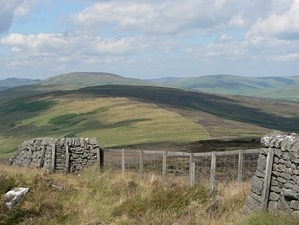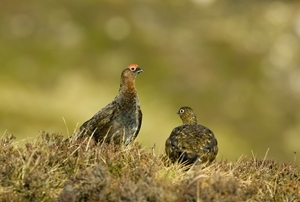Key points
- Heather moorland is an important habitat for breeding birds but has declined across the UK.
- The authors studied changes in heather cover over 70 years in relation to changes in sheep grazing on Langholm Moor, and examined the impact on red grouse.
- Between 1948 and 2009, when Langholm Moor was heavily grazed by sheep, the area with vegetation dominated by heather declined from 53% to 14%.
- From 2011 sheep grazing across the moor was reduced, which allowed heather-dominated vegetation cover to increase to 18% by 2015.
- Changes in heather cover were associated with changes in grouse abundance, but only in areas where heather cover was reduced to a third or less of total cover.
- Overall, the presence of gamekeepers was more important in determining changes in grouse densities than levels of sheep grazing and the extent of heather habitat.
- Driven grouse shooting can provide an economic incentive to maintain and restore heather habitat. On Langholm Moor, however, afforestation in the surrounding landscape and isolation from other moors may have increased the sensitivity of the grouse population to predation.
Background
 Heather moorland is a characteristic habitat of the Scottish uplands, and considered of international importance for its global rarity and the breeding birds it supports. In the UK, heather is traditionally managed by controlled burning and livestock grazing. However, intensive grazing or burning can result in heather loss and conversion into grassland, whilst lack of management can lead to scrub and woodland growth.
Heather moorland is a characteristic habitat of the Scottish uplands, and considered of international importance for its global rarity and the breeding birds it supports. In the UK, heather is traditionally managed by controlled burning and livestock grazing. However, intensive grazing or burning can result in heather loss and conversion into grassland, whilst lack of management can lead to scrub and woodland growth.
In Scotland, afforestation and increases in grazing pressure by sheep led to a 25% decline in the area of heather-dominated moorland between the 1940s and 1980s. The loss of heather has been slower in areas managed for red grouse shooting, because heather is required as the main food source for grouse. However, the area managed for grouse shooting in Scotland also declined during the 20th century, together with the number of gamekeepers who routinely control generalist predators. These large-scale changes in land use have contributed to declines in several moorland birds of conservation concern.
In this study, the authors analysed long-term data from Langholm Moor in southwest Scotland to test the response of both heather cover and red grouse abundance to changing sheep grazing and grouse management intensities over eight decades. These results are then set into the context of long-term changes in land use in the wider landscape, in order to understand how this may have influenced the red grouse population of the study area.
What they did
 The study looked at 70 years (1948-2018) on Langholm Moor in southwest Scotland, which was dominated by a mosaic of heather moorland and grassland. From the 19th century until 1999, and then from 2008 to 2016, the moorland was managed for both driven grouse shooting and for sheep farming, although grouse have not been shot since 1996. Historically, the grouse moor was divided into five ‘beats’, each managed by a gamekeeper to maximise grouse numbers for shooting, which included the legal control of generalist predators (e.g. red foxes and carrion crows) and controlled heather burning. Sheep grazed the moor virtually year-round. To support heather recovery, sheep numbers were reduced or removed from 1990 onwards. By 2011, grazing was lower or absent from 60% of the moor.
The study looked at 70 years (1948-2018) on Langholm Moor in southwest Scotland, which was dominated by a mosaic of heather moorland and grassland. From the 19th century until 1999, and then from 2008 to 2016, the moorland was managed for both driven grouse shooting and for sheep farming, although grouse have not been shot since 1996. Historically, the grouse moor was divided into five ‘beats’, each managed by a gamekeeper to maximise grouse numbers for shooting, which included the legal control of generalist predators (e.g. red foxes and carrion crows) and controlled heather burning. Sheep grazed the moor virtually year-round. To support heather recovery, sheep numbers were reduced or removed from 1990 onwards. By 2011, grazing was lower or absent from 60% of the moor.
The authors used aerial photographs from 1948, 1988, 2009 and 2015 to estimate changes in heather cover throughout the study period. Heather was classified in each 1ha square as either no heather, less than half, or more than half of the vegetation cover. In addition, heather cover was also estimated from ground vegetation surveys in 1997, 2007, 2012, 2015 and 2018 in ten 50ha blocks of representative moorland habitat, where grouse were also counted. Changes in red grouse abundance were estimated from shooting bags (1951-1992) and grouse counts using pointing dogs (1992-2018).
The authors quantified changes in heather cover in relation to changes in sheep grazing, and related this to changes in red grouse abundance. For comparison, they also quantified vegetation changes in the wider landscape around Langholm Moor, using data from the National Countryside Monitoring Scheme (1940s and 1970s) and the Land Cover Map (2015).
What they found
Between 1948 and 2009, when Langholm Moor was heavily grazed by sheep, the area of heather-dominated vegetation declined from 53% to 14% over the whole study area. Localised reductions in sheep numbers in 1990 did not stop the overall heather decline between 1988 and 2009. However, large-scale sheep reductions from 2011 started to reverse the decline and allowed heather-dominated vegetation to increase to 18% cover by 2015.
Changes in heather cover were only associated with changes in grouse abundance in areas where heather-dominated vegetation cover was reduced below thresholds of 27% for effects on pre-breeding density and 17% for post-breeding density (these thresholds were calculated by computer modelling).
The number of grouse shot between 1951 and 1992 remained high in the main beats, where heather remained the dominant vegetation on 37–65% of the area, but declined in the surrounding areas, where heather declines were more severe (-77%) and from where heather was almost completely lost (only 8% of heather-dominated vegetation in 1988).
Since the 1940s, the wider landscape around Langholm Moor, i.e. the historical districts of Annandale & Eskdale and Roxburgh, lost more than 80% of its heather moorland to afforestation and conversion into grassland. Vegetation on Langholm Moor in 2015, however, still resembled that of the wider region from the 1940s, being dominated by semi-natural grassland and heather moorland with only 3% woodland cover.
What does this mean?
 Red grouse densities on managed grouse moors tend to be higher on areas with high heather cover, and the loss of heather has been widely associated with long-term declines in grouse bags on many UK moors, including Langholm Moor. However, the results of this study showed that long-term declines in heather cover were only responsible for grouse declines in areas where heather-dominated vegetation was reduced to a third or less of total cover, but not in the four main beats where heather-dominant vegetation was largely retained. Here, rapid declines in grouse bags between 1992 and 1996 were explained by increased predation by hen harriers and peregrines (Joint Raptor Study), leading to the cessation of shooting and subsequently that of grouse management.
Red grouse densities on managed grouse moors tend to be higher on areas with high heather cover, and the loss of heather has been widely associated with long-term declines in grouse bags on many UK moors, including Langholm Moor. However, the results of this study showed that long-term declines in heather cover were only responsible for grouse declines in areas where heather-dominated vegetation was reduced to a third or less of total cover, but not in the four main beats where heather-dominant vegetation was largely retained. Here, rapid declines in grouse bags between 1992 and 1996 were explained by increased predation by hen harriers and peregrines (Joint Raptor Study), leading to the cessation of shooting and subsequently that of grouse management.
The reductions in sheep grazing as part of the Langholm Moor Demonstration Project in 2011 were important in starting to reverse the long-term decline in heather cover. However, increased heather cover did not give rise to increased grouse productivity or survival, and the presence of gamekeepers was more important in determining changes in grouse densities than levels of sheep grazing and the extent of heather habitat. Grouse density increased after keepering was resumed in 2008, but declined again when keepering ceased in 2016 despite ongoing heather restoration. This suggests that grouse numbers were primarily limited by predation, not by habitat.
Due it its primary use as a grouse moor, Langholm Moor remained unafforested. However, the loss of moorland in the wider landscape isolated Langholm Moor from other heather moors. Changes in grouse numbers therefore depended entirely on their local productivity and survival, which were both sensitive to predation. Land use changes in the wider landscape (i.e. afforestation, sheep farming, and release of lowland gamebirds) may also have resulted in higher numbers of generalist predators.
Driven grouse shooting can provide an economic incentive to maintain and restore heather habitats, which then support not only red grouse but also other ground-nesting birds of conservation concern. However, driven grouse moors have also been associated with illegal killing of raptors that predate grouse, as they can reduce grouse densities sufficiently to undermine grouse moor economics. In turn, the loss of income from grouse shooting may encourage the development of other land uses, such as intensive sheep farming, commercial forestry, or renewable energy, which may be incompatible with retaining heather moorland and its associated wildlife.
About the LMDP
This study was part of the Langholm Moor Demonstration Project, a long-running collaboration between the GWCT, SNH, Buccleuch Estates, the RSPB and Natural England, which aimed to resolve conflict between driven grouse shooting and raptor conservation.
Read the original abstract
Ludwig, S.C., Aebischer, N.J., Richardson, M., Roos, S., Thompson, D.B.A., Wilson, J.D. & Baines, D. (2020) Differential responses of heather and red grouse to long-term spatio-temporal variation in sheep grazing. Biodiversity and Conservation 29, 2689-2710.